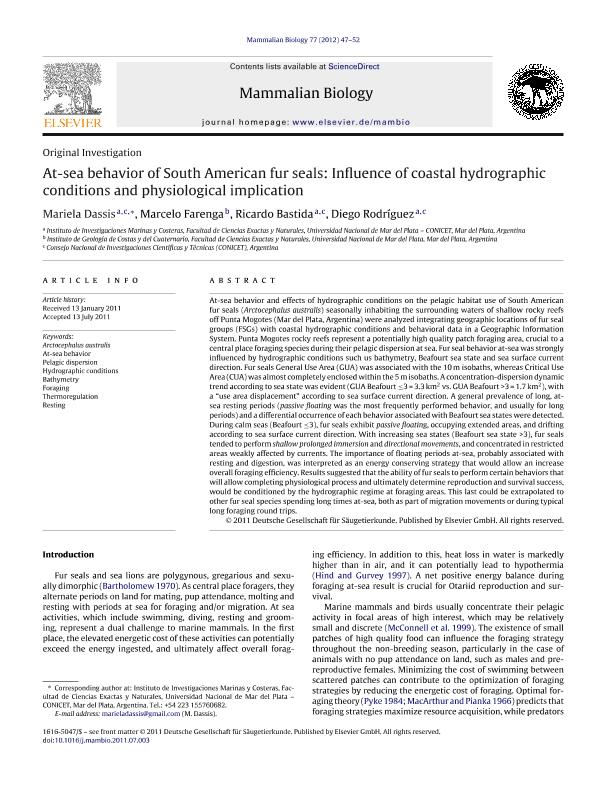Mostrar el registro sencillo del ítem
dc.contributor.author
Dassis, Mariela

dc.contributor.author
Farenga, Marcelo Omar

dc.contributor.author
Bastida, Ricardo Oscar

dc.contributor.author
Rodriguez, Diego Horacio

dc.date.available
2023-06-06T11:23:26Z
dc.date.issued
2012-01
dc.identifier.citation
Dassis, Mariela; Farenga, Marcelo Omar; Bastida, Ricardo Oscar; Rodriguez, Diego Horacio; At-sea behaviour of South American fur seals: influence of coastal hydrographic conditions and physiological implicances; Elsevier Gmbh; Mammalian Biology; 77; 1; 1-2012; 47-52
dc.identifier.issn
1616-5047
dc.identifier.uri
http://hdl.handle.net/11336/199684
dc.description.abstract
At-sea behavior and effects of hydrographic conditions on the pelagic habitat use of South American fur seals (Arctocephalus australis) seasonally inhabiting the surrounding waters of shallow rocky reefs off Punta Mogotes (Mar del Plata, Argentina) were analyzed integrating geographic locations of fur seal groups (FSGs) with coastal hydrographic conditions and behavioral data in a Geographic Information System. Punta Mogotes rocky reefs represent a potentially high quality patch foraging area, crucial to a central place foraging species during their pelagic dispersion at sea. Fur seal behavior at-sea was strongly influenced by hydrographic conditions such us bathymetry, Beafourt sea state and sea surface current direction. Fur seals General Use Area (GUA) was associated with the 10m isobaths, whereas Critical Use Area (CUA) was almost completely enclosed within the 5misobaths. A concentration-dispersion dynamic trend according to sea state was evident (GUA Beafourt ≤3 = 3.3km2 vs. GUA Beafourt >3 = 1.7km2), with a ?use area displacement? according to sea surface current direction. A general prevalence of long, atsea resting periods (passive floating was the most frequently performed behavior, and usually for long periods) and a differential occurrence of each behavior associated with Beafourt sea states were detected. During calm seas (Beafourt ≤3), fur seals exhibit passive floating, occupying extended areas, and drifting according to sea surface current direction. With increasing sea states (Beafourt sea state >3), fur seals tended to perform shallow prolonged immersion and directional movements, and concentrated in restricted areas weakly affected by currents. The importance of floating periods at-sea, probably associated with resting and digestion, was interpreted as an energy conserving strategy that would allow an increase overall foraging efficiency. Results suggested that the ability of fur seals to perform certain behaviors that will allow completing physiological process and ultimately determine reproduction and survival success, would be conditioned by the hydrographic regime at foraging areas. This last could be extrapolated to other fur seal species spending long times at-sea, both as part of migration movements or during typical long foraging round trips.
dc.format
application/pdf
dc.language.iso
eng
dc.publisher
Elsevier Gmbh

dc.rights
info:eu-repo/semantics/openAccess
dc.rights.uri
https://creativecommons.org/licenses/by-nc-sa/2.5/ar/
dc.subject
ARCTOCEPHALUS AUSTRALIS
dc.subject
AT-SEA BEHAVIOR
dc.subject
BATHYMETRY
dc.subject
FORAGING
dc.subject
HYDROGRAPHIC CONDITIONS
dc.subject
PELAGIC DISPERSION
dc.subject
RESTING
dc.subject
THERMOREGULATION
dc.subject.classification
Ecología

dc.subject.classification
Ciencias Biológicas

dc.subject.classification
CIENCIAS NATURALES Y EXACTAS

dc.title
At-sea behaviour of South American fur seals: influence of coastal hydrographic conditions and physiological implicances
dc.type
info:eu-repo/semantics/article
dc.type
info:ar-repo/semantics/artículo
dc.type
info:eu-repo/semantics/publishedVersion
dc.date.updated
2023-06-05T12:00:07Z
dc.journal.volume
77
dc.journal.number
1
dc.journal.pagination
47-52
dc.journal.pais
Alemania

dc.description.fil
Fil: Dassis, Mariela. Consejo Nacional de Investigaciones Científicas y Técnicas. Centro Científico Tecnológico Conicet - Mar del Plata. Instituto de Investigaciones Marinas y Costeras. Universidad Nacional de Mar del Plata. Facultad de Ciencias Exactas y Naturales. Instituto de Investigaciones Marinas y Costeras; Argentina
dc.description.fil
Fil: Farenga, Marcelo Omar. Universidad Nacional de Mar del Plata. Facultad de Ciencias Exactas y Naturales. Instituto de Geología de Costas y del Cuaternario. Provincia de Buenos Aires. Gobernación. Comisión de Investigaciones Científicas. Instituto de Geología de Costas y del Cuaternario; Argentina
dc.description.fil
Fil: Bastida, Ricardo Oscar. Consejo Nacional de Investigaciones Científicas y Técnicas. Centro Científico Tecnológico Conicet - Mar del Plata. Instituto de Investigaciones Marinas y Costeras. Universidad Nacional de Mar del Plata. Facultad de Ciencias Exactas y Naturales. Instituto de Investigaciones Marinas y Costeras; Argentina
dc.description.fil
Fil: Rodriguez, Diego Horacio. Consejo Nacional de Investigaciones Científicas y Técnicas. Centro Científico Tecnológico Conicet - Mar del Plata. Instituto de Investigaciones Marinas y Costeras. Universidad Nacional de Mar del Plata. Facultad de Ciencias Exactas y Naturales. Instituto de Investigaciones Marinas y Costeras; Argentina
dc.journal.title
Mammalian Biology

dc.relation.alternativeid
info:eu-repo/semantics/altIdentifier/url/http://www.sciencedirect.com/science/article/pii/S1616504711000826
dc.relation.alternativeid
info:eu-repo/semantics/altIdentifier/doi/http://dx.doi.org/10.1016/j.mambio.2011.07.003
Archivos asociados
